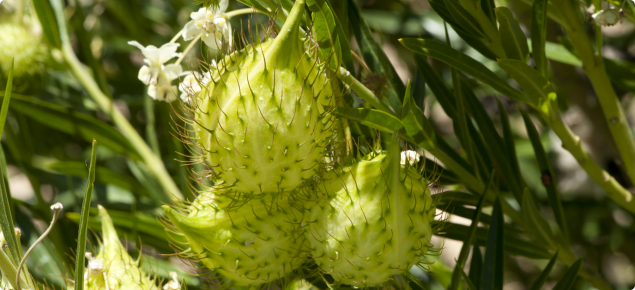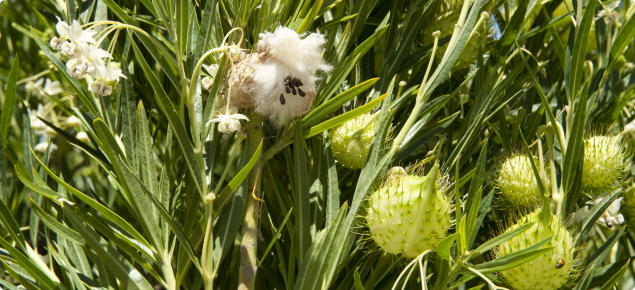What you should know about narrow-leaf cotton bush
Narrow-leaf cotton bush (Gomphocarpus fruticosus) is in the family Asclepiadaceae which contains many toxic weeds and garden plants. The members of this family typically have thick white sap, which gives rise to the common name of the milkweed family. Some other plants in the family are rubbervine (Cryptostegia grandiflora), calotrope (Calotropis procera), moth plant (Araujia sericifera), redhead cotton bush (Asclepias curassavica) and stapelia (Orbea spp.).
Narrow-leaf cotton bush and the closely related balloon cotton bush (G. physocarpus) get their common names from the silky white thread-like attachments on their seeds. Narrow-leaf cotton bush is also known as swan plant because of the shape of its seed pods. Balloon cotton bush has more rounded seed pods. Narrow-leaf cotton bush is native to South Africa and Ethiopia and was introduced to Australia as a garden plant. It is a weed right across Australia, as well as parts of New Zealand and the Mediterranean basin. Narrow-leaf cotton bush is a food plant for the brightly coloured caterpillars (larvae) of the wanderer butterfly (Danaus plexippus). The wanderer is native to North America but has now established in Australia, due to the presence of narrow-leaf cotton bush and other introduced plants that provide food for its larvae. Narrow-leaf cotton bush is a declared plant but is still found in cultivation.
Why narrow-leaf cotton bush matters
Narrow-leaf cotton bush is a common weed in the south-west of Western Australia. It invades run down or low fertility pastures where it displaces useful species such as clover. Narrow-leaf cotton bush and its close relatives contain cardiac glycosides, which are toxic to humans and livestock. Stock wouldn’t normally eat the plant because its acrid latex makes it extremely unpalatable but it may cause problems as a contaminant of hay or chaff. The main symptom of narrow-leaf cotton bush poisoning is severe gastroenteritis, which shows up as severe congestion of the alimentary canal. Narrow-leaf cotton bush also invades riparian areas where it competes with native plants.
What to look for
Narrow-leaf cotton bush is a shrub growing up to two metres in height. It can form dense thickets covering many hectares. The opposite leaves are 6–18mm wide and 5–12.5cm long. The creamy white flowers are about 1cm across and have a short corolla tube. The flowers form in drooping clusters from October to April. The distinctive seed pods are puffy, swan-shaped structures up to 6cm long and covered in soft spines. It could be confused with balloon cotton bush, which also reaches 2m in height, but has more rounded seed pods. There are hybrids of these two species that produce intermediate seed pods. Narrow-leaf cotton bush is most prevalent on the Darling Scarp and the Swan Coastal Plain between Perth and Bunbury, though it may be found from Gingin to Esperance.
Life history of narrow-leaf cotton bush
Narrow-leaf cotton bush spreads by seeds, which usually germinate in spring or autumn, but can germinate at any time in warm, moist conditions. Seedlings have the ability to resprout from the crown or root if the above ground parts of the plant are damaged. The plants grow through summer and usually flower in the second year from October to April.
What you can do about narrow-leaf cotton bush
Practice good biosecurity to avoid introducing narrow-leaf cotton bush or other weeds and pests to your property. Do not cultivate narrow-leaf cotton bush as a garden plant and avoid purchasing soil or other landscaping supplies that could be contaminated with weed seeds or bulbs. Take particular care when purchasing fodder - cheap hay is not a bargain if it is full of weed seeds or toxic plants. Ensure contractors entering your property have clean equipment to avoid the introduction of new weeds – install a washdown bay if necessary. If you have narrow leaf cotton bush on your property, take care to prevent it spreading to other properties. Control small infestations before they spread. Join forces with your neighbours and local government authority to remove narrow-leaf cotton bush and other weeds. Narrow-leaf cotton bush has a shallow root system so small infestations can be dealt with by hand pulling - make sure you get all the roots to prevent suckering. Take appropriate measures to avoid contact with the toxic sap, such as wearing rubber gloves and overalls, and washing hands thoroughly before eating. Contact with the sap could cause a rash or other symptoms for which medical advice should be sought.
Destroy any seeds in a way to avoid spreading the plant. Larger infestations are best dealt with by a combination of spraying, slashing, burning and pasture management. Burning heavy infestations of cotton bush is an effective, low cost option which damages seed on and near the soil surface. The reduction in the soil seed bank allows increased pasture production. Ploughed firebreaks can provide an ideal seedbed for narrow-leaf cotton bush and other weeds, so chemical firebreaks may be better. Chemical firebreaks have the added advantage of providing a firm surface that can be used as an access track or an escape route in the event of fire.
Control options
Seedlings, plants less than 1m tall
Minor infestations or small patches of young seedling plants can be sprayed with glyphosate or physically removed by grubbing or hand pulling. At this growth stage they are unlikely to have seeded and can be disposed of by drying and burning. Larger infestations are effectively controlled using glyphosate to ensure all seedlings are controlled before they mature and produce seed.
Mature plants more than 1m tall
Small areas can be sprayed or physically removed by grubbing or pulling. Plants that have been removed will dry out quickly and should be burnt or deep buried. Mature plants with seed pods attached have the potential to spread seed and infest new areas when moved away from their original location and should be disposed of as close to the infestation as possible. Large infestations of mature plants can be managed and controlled using various techniques including slashing, burning and spraying. All methods reduce the potential for plants to produce seed. Slashing and burning must be followed up with herbicide treatment to control regrowth and seedlings. Spraying with glyphosate mixed with metsulfuron methyl is very effective in controlling larger cotton bush plants and is best applied by a high volume hand lead sprayer. Plants should be sprayed until the leaves are wet, almost to the point that liquid is running off. The table below provides the amount of glyphosate herbicide per 10L knapsack or 100L tank mix for products that contain 360, 450 or 540g/L or 680g/kg of glyphosate. Other herbicides used for the control of narrow-leaf cotton bush include triclopyr and metsulfuron methyl. In bushland areas, wipe the leaves with a mixture of 1L glyphosate plus 2L water before flowering when the plants are actively growing in spring to early summer. The larvae of the wanderer butterfly occasionally cause stem and leaf damage to cotton bush, however it is not sufficient to kill infestations of the plant.
Summary of control options for narrow leaf cotton bush seedlings and immature plants (<1m tall)
| Treatment | Glyphosate (sold under various trade names). Use with a wetting agent. |
|---|---|
| Active ingredient |
|
| Amount of product for 10L sprayer |
|
| Amount of product for 100L tank |
|
| Time of application | Treat actively growing plants (i.e. Spring to December) |
| Remarks | It is important to spray plants to the point of run off for good control. Plants that are stressed may not be controlled effectively. |
| More information and other control methods | Slash established bushes during winter and burn. Cultivate or grub regrowth. Use Roundup®Biactive or Razor around sensitive aquatic areas. |
| Treatment | Triclopyr (sold under various trade names). Use crop-oil such as Uptake @ 500mL 100L, or DC-Trate @ 1L/100L. |
|---|---|
| Active ingredient | Triclopyr 600g/L |
| Amount of product for 10L sprayer | 30mL |
| Amount of product for 100L tank | 300mL |
| Time of application | — |
| Remarks | Use in place of glyphosate to preserve grass pasture. |
| More information and other control methods | — |
Summary of control options for narrow leaf cotton bush mature plants (>1m tall)
| Treatment | Glyphosate + metsulfuron (sold under various trade names). Use with a wetting agent. |
|---|---|
| Active ingredient |
+ metsulfuron methyl 600g/kg |
| Amount of product for 10L sprayer |
|
| Amount of product for 100L tank |
|
| Time of application | Treat actively growing plants (i.e. Spring to December) |
| Remarks | Lower the rate of metsulfuron methyl (1g/100L) in areas where sensitive native species occur. |
| More information and other control methods | Physically remove or slash plants if there is potential for off target damage to sensitive plant species. Treat regrowth and seedlings with glyphosate. |
Further information
For more information on narrow leaf cotton bush, search this website or contact the Pest and Disease Information Service.



